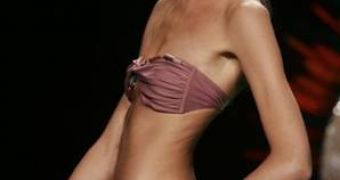If Rubens had had to choose his "Three Graces" amongst the present-day fashion models, he would have rather preferred to paint three skeletons.
And to help them achieve that, the Council of Fashion Designers of America (CFDA), released recommendations targeting healthier models, not anorexic, bulimic or chain-smokers.
The suggestions are not mandatory and say that models under 16 should be kept off the runway while those under 18 should not be put to work at fittings or photo shoots past midnight.
Those in the fashion industry should be trained to detect the early symptoms of eating disorders. Models found suffering from an eating disorder should receive professional help and be permitted to continue work with that professional's approval.
Workshops on the causes and effects of eating disorders, but also of smoking and tobacco-related issues, should be founded. Alcohol and smoking should be forbidden during fashion shows, while the organizers should provide healthy meals and snacks. These recommendations miss the Body Mass Index.
But in September 2006, at the Madrid Fashion Week, models with a BMI under 18 were not allowed to take part. World Health Organization says that a BMI under 18.5 reveals underweight.
Italian government officials also got into the issue, prompted especially by the death of Brazilian model Ana Carolina Reston, reported to have weighed 88 pounds (36 kg) when she died: models under 16 cannot be hired and all models must be checked for eating disorders.
"The CFDA Health Initiative is about awareness and education, not policing. Therefore, the committee is not recommending that models get a doctor's physical examination to assess their health or body-mass index to be permitted to work. Eating disorders are emotional disorders that have psychological, behavioral, social and physical manifestations, of which body weight is only one." stated the CFDA.
"The designers' understanding of the issue is that BMI is just one factor in a long list of criteria to identify eating disorders. A lot of the girls who work the runway are genetically thin. You go backstage and you see a lot of girls eating a lot of food and they're not gaining weight," said CFDA Executive Director Steven Kolb.
"As an industry, fashion has always been concerned about health. Here at the CFDA, we've been in the forefront in terms of efforts (such as) Fashion Targets Breast Cancer and HIV/AIDS awareness. As the issue of underweight models became global, we, as a group, outside of what other countries have done, decided to do something," added Kolb.
Michael Vollbracht, the creative director at Bill Blass, believes that industry will adjust to a less-thin thin model in time.
"Thin is always in, it's how you show clothes. But then those size 0 styles are plucked by stylists for Hollywood actresses who then feel fat - and then diet - when they can't fit into the tiny garments, and there are so many girls and women who then look up to the stars," said Vollbracht.
"In the 1980s and early '90s, supermodels Claudia Schiffer and Cindy Crawford had more curvaceous figures. It'll take some time to change back."

 14 DAY TRIAL //
14 DAY TRIAL //